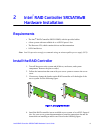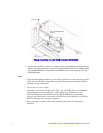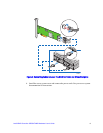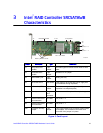
1 Intel® RAID Controller SRCSATAWB Hardware User’s Guide
1 Overview
The Intel
®
RAID Controller SRCSATAWB is a high-performance intelligent PCI-
Express* SATA RAID controller that offers reliability, high performance, and fault-
tolerant disk subsystem management. This is an RAID solution meets the internal storage
needs of workgroup, department, or enterprise systems to use cost-effective SATA media.
As a third generation PCI Express storage controller, the Intel
®
RAID Controller
SRCSATAWB addresses the demand for increased data throughput and scalability
requirements across entry-level and midrange server platforms.
The controller can be connected to up to eight drives directly and allows the use of
expanders to connect to additional drives. See the ANSI SAS standard, version 1.0
specification for more information about the use of expanders.
SATA is a serial, point-to-point, device interface that uses simplified cabling, smaller
connectors, lower pin counts, and lower power requirements than parallel SCSI.
The optional Intel
®
RAID Smart Battery AXXRSBBU4 provides cached data protection
for the RAID controller, even during system failures.
Intel
®
RAID Controller SRCSATAWB
The Intel
®
RAID Controller SRCSATAWB is an intelligent low-profile RAID adapter
with an integrated LSI* 1078 RAID-On-Chip chipset, providing both a SATA controller
and a RAID engine. With 128 MB RAM built onto the board and eight independent ports
using two SFF-8087 mini multi-lane connectors, this controller supports up to 16
enterprise-class SATA devices and 64 logical drives. The PCI-Express* connector fits into
an x4 or x8 PCI-Express slot capable of 2.5 Gbps per lane over PCI Express* x4 with a
3.0 Gbps point to point transfer rate.
Protocol Support
• Serial ATA (SATA) protocol defined by the Serial ATA specification, version 1.0a.
• SATA II Protocol: Communication with other SATA II devices.
• Serial Management Protocol (SMP): Topology management information sharing
with expanders.
• Serial Tunneling Protocol (STP) support for SATAII through expander interfaces.


















